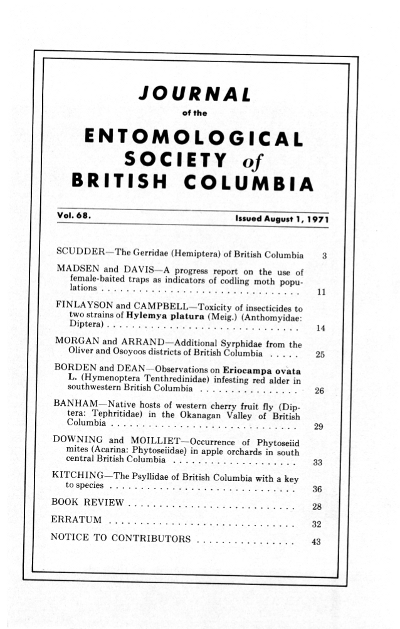Occurrence of Phytoseiid mites (Acarina: Phytoseiidae) in apple orchards in south central British Columbia
Keywords:
Acarina, Phytoseiidae, apple orchardsAbstract
Sprayed and nonsprayed apple trees in the interior of British Columbia were sampled from 1967-70 for mites belonging to the family Phytoseiidae. <i>Typhlodromus occidentalis</i> Nesbitt and <i>T. columbiensis</i> Chant were the only species commonly found in sprayed orchards. <i>T. occidentalis</i> was more abundant. In nonsprayed orchards, <i>T. caudiglans</i> Schuster was practically the only phytoseiid found in the Okanagan and Similkameen valleys whereas it and <i>Phytoseius macropilis</i> (Banks) were the most common mites found in samples from higher rainfall districts bordering the Shuswap and Arrow Lakes. <i>T. pyri</i> Scheuten was less widely distributed than the above mites but was found in large numbers on nonsprayed trees in the Shuswap area and at Summerland in a dwarf apple orchard that is irrigated by overhead sprinklers.References
Anderson, N.H., C.V.G. Morgan, and D.A. Chant. 1958. Notes on occurrence of Typhlodromus and Phytoseius spp. in southern British Columbia (Acarina: Phytoseiinae). Can. Ent. 90:275-279.
Chant, D.A. 1957. Descriptions of some phytoseiid mites (Acarina: Phytoseiidae). Part I. Nine new species from British Columbia with keys to the species of British Columbia. Can. Ent. 89:239-299.
Chant, D.A. 1959. Phytoseiid mites (Acarina: Phytoseiidae). Part II. A taxonomic review of the family Phytoseiidae with descriptions of 38 new species. Can. Ent. 91 (Suppl. 12) 121 pp.
Chant, D.A. 1965. Generic concepts in the family Phytoseiidae (Acarina: Mesostigmata). Can. Ent. 97:351-374.
Collyer, Elsie. 1964. A summary of experiments to demonstrate the role of Typhlodromus pyri Scheul. in the control of Panonychus ulmi Koch in England. Proc. lst Int. Cong. Acarology, Fort Collins (196:1) 36:1-371.
Downing, R.S. and J.C. Arrand. 1968. Integrated control of orchard mites in British Columbia. B.C. Dept. Agr. Publ. 68-4.
Henderson, C.F. and H.Y. McBurnie. 1943. Sampling technique for determining populations of citrus red mite and its predators. U.S. Dept. Agr. Circ. 67l.
Hoyt, S.C. 1969. Integrated control of insects and biological control of mites on apple in Washington. J. Econ. Ent. 62:74-86.
Laing, J.E. 1969. Life history and life table of Metaseiulus occidentalis. Ann. Ent. Soc. Amer. 62:978-982.
Lee, M.S. and D.W. Davis. 1968. Life history and behaviour of the predatory mite Typhlodromus occidentalis in Utah. Ann. Ent. Soc. Amer. 6l:25l-255.
Morgan, C.V.G. et al. 1955. Methods for estimating orchard mite populations, especially with the mite brushing machine. Can. Ent. 87:189-200.
Poe, Sidney L. and Wilbur R. Enns. 1969. Predaceous mites (Acarina: Phytoseiidae) associated with Missouri orchards. Trans. Missouri Acad. Sc. 3(1969): 69-82.
Putman, Wm. L. 1962. Life-history and behaviour of the predaceous mite, Typhlodromus (T) caudiglans Schuster (Acarina: Phytoseiidae) in Ontario with notes on the prey of related species. Can. Ent. 94:163-177.
Downloads
Published
Issue
Section
License
Authors who publish with the Journal of the Entomological Society of British Columbia agree to the following terms:
-Authors retain copyright and grant the journal right of first publication with the work simultaneously licensed under a Creative Commons Attribution License that allows others to share the work with an acknowledgement of the work's authorship and initial publication in this journal.
-Authors are able to enter into separate, additional contractual arrangements for the non-exclusive distribution of the journal's published version of the work (e.g., post it to an institutional repository or publish it in a book), with an acknowledgement of its initial publication in this journal.
-Authors are permitted and encouraged to post their work online (e.g., in institutional repositories or on their website) prior to and during the submission process, as it can lead to productive exchanges, as well as earlier and greater citation of published work (See The Effect of Open Access).


